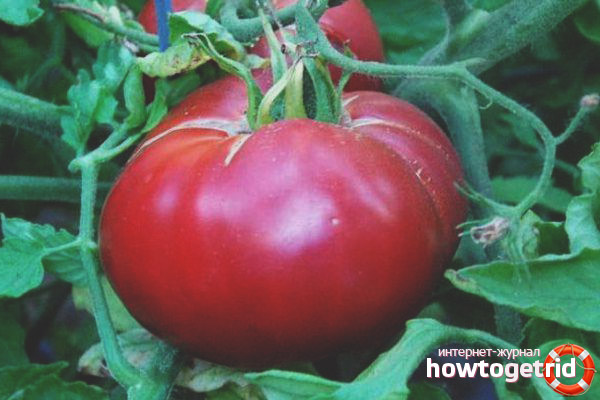The content of the article
Each gardener wants to find the most fruitful and delicious tomato variety. Such characteristics are combined in a variety called the “Sugar Elephant”. High yields are demonstrated even with minimal maintenance.
Grade characteristics
The Sugar Elephant variety was bred in 2009. It is included in the State Register as a tomato, which is intended for cultivation in greenhouses in the northern regions, as well as in open ground in the middle lane and in the south.
In addition to this variety, several other "elephants" were created. As a rule, their qualities are very similar. The differences in most cases are the color of ripe tomatoes.
A plant of this variety is interdeterminant, its height is not limited. The main stem can reach 150-180 centimeters in height. It is necessary to tie the bush to a vertical support, as well as constantly remove the side stepsons. To get the largest possible crop, the bush must be formed into one or two stems.
Variety Sugar elephant of medium early ripeness. The ripening period (from planting seeds in the soil to the formation of ripe fruit on the bushes) is about 115 days.
Sheets of a bush of a standard form. In some cases, leaves that look similar to potato tops grow on the plant. Some gardeners argue that the shape of the leaves is different for the reason that the seeds are produced by different manufacturers.
One of the main advantages of the tomato variety Sugar elephant is that it is resistant to almost all diseases characteristic of this vegetable crop. The only exception is vertex rot. To prevent its occurrence, you should regularly feed the soil using fertilizers containing potassium.
Crop description
If the characteristic of the plant itself has no differences from many other varieties of tomatoes belonging to the Elephant series, then the description of the tomatoes will be completely different:
- Dessert fruits.
- Ripe tomatoes have a sweet taste, sourness is absent.
- The weight of each fruit is 200-600 grams.
- If you regularly make mineral and organic top dressing, the mass of tomatoes can be increased to 800 grams.
- From each bush you can remove more than 4 kilograms of the crop.
- The fruits have an oval shape, slightly flattened at the ends.
- The skin is thin, shiny.
- Universal application for all culinary purposes.
- Shelf life is not long, after picking ripe tomatoes they must be used immediately for fresh consumption or processing.
- Overripe fruits can be used to make lecho and tomato juices.
- Tomatoes may crack during transport.
How to grow and care for the variety

When growing a tomato, the sugar elephant in the beds is very easy to care for. You need to carry out a small number of events in order to collect a large number of crops. First of all, regular loosening of the soil is mandatory. This should be done once a week. Due to this, oxygen will freely flow to the roots of the plant. In addition, you need to ensure that weeds do not grow on the beds. If you start the garden, then the bushes will grow poorly, since all the nutrients will go into the weeds.
To increase productivity, it is necessary to timely remove ripened fruits from the plant. This will help the stem to develop more actively, and also contribute to the formation of a larger number of ovaries. Frequent harvesting will help get more large and tasty tomatoes.
It must be remembered that regular application of organics or mineral top dressing is necessary. 7 days after planting seedlings in a permanent place, you need to start fertilizing it. A kilogram of mullein and one and a half large spoons of nitrophoska are bred in 10 liters of warm water. The mixture must be well mixed and used to water the bushes under the root.
The second time a plant should be fed after the flowering of the first inflorescence. 500 grams of bird droppings, 10 grams of potassium sulfate and 20 grams of superphosphate are bred in 10 liters of warm water. 500 ml of fertilizer is poured under each plant.
Then you need to fertilize the culture, depending on the appearance of the plant. With its poor growth, you can continue to feed.
Video: how to water tomatoes










Submit